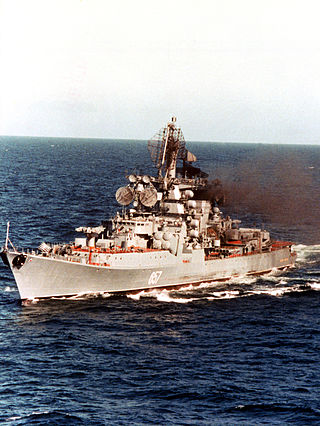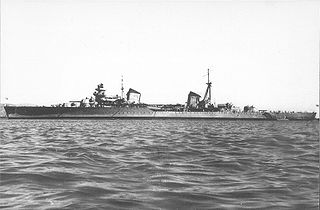
The Kresta II class, Soviet designation Project 1134A Berkut A, was a class of guided missile cruiser built by the Soviet Union for the Soviet Navy. The NATO lists the class as "cruisers" mainly due to the Metel anti-ship missile system capable to strike not only submarines but also surface vessels.

The Sverdlov-class cruisers, Soviet designation Project 68bis, were the last conventional gun cruisers built for the Soviet Navy. They were built in the 1950s and were based on Soviet, German, and Italian designs and concepts developed prior to the Second World War. They were modified to improve their sea capabilities, allowing them to run at high speed in the rough waters of the North Atlantic. The basic hull was more modern and had better armor protection than the vast majority of post-World War II gun cruiser designs built and deployed by peer nations. They also carried an extensive suite of modern radar equipment and anti-aircraft artillery. The Soviets originally planned to build 40 ships in the class, to be supported by the Stalingrad-class battlecruisers and aircraft carriers.
Kalinin (Калинин) was one of six Kirov-class cruisers built for the Soviet Navy in the Russian Far East from components shipped from European Russia during World War II. The ship was one of the last pair constructed, known as the Project 26bis2 subclass. Completed at the end of 1942 and assigned to the Pacific Fleet, she saw no action during the Soviet–Japanese War in 1945 and served into the Cold War. Sometimes serving as a flagship, her post-war career was uneventful until she was disarmed and converted into a floating barracks in 1960. She was scrapped in the early 1960s.

Kirov was a Project 26 Kirov-class cruiser of the Soviet Navy that served during the Winter War and World War II, and into the Cold War. She attempted to bombard Finnish coast defense guns during action in the Winter War, but was driven off by a number of near misses that damaged her. She led the Evacuation of Tallinn at the end of August 1941, before being blockaded in Leningrad where she could only provide gunfire support during the siege of Leningrad. She bombarded Finnish positions during the Vyborg–Petrozavodsk Offensive in mid-1944, but played no further part in the war. Kirov was reclassified as a training cruiser on 2 August 1961 and sold for scrap on 22 February 1974.

The Myōkō-class cruisers were a series of four heavy cruisers built for the Imperial Japanese Navy in the late 1920s. Three were lost during World War II.

Murmansk was a light cruiser project no. 68-bis of the Soviet and later the Russian Navy's Northern Fleet.

Molotov was a Project 26bis Kirov-class cruiser of the Soviet Navy that served during World War II and into the Cold War. She supported Soviet troops during the Siege of Sevastopol, the Kerch-Feodosiya Operation and the amphibious landings at Novorossiysk at the end of January 1943.

Mikhail Kutuzov is a light cruiser project no. 68-bis of the Soviet and later the Russian Navy's Black Sea Fleet.

Vasily Chapayev was a Project 1134A Berkut A class cruiser of the Soviet Navy named for Soviet commander Vasily Chapayev. The ninth ship of the class, the vessel was launched in 1974 and served during the Cold War with the Pacific Fleet. Based at Vladivostok, the ship travelled extensively in the Indian and Pacific Oceans, visiting a large number of friendly ports in Angola, Ethiopia, India, Mozambique and Yemen. In 1978 and 1979, the vessel formed part of a flotilla of Soviet vessels including the Project 68bis cruiser Admiral Senyavin that supported Vietnam in the aftermath of the Sino-Vietnamese War. In 1982, Vasily Chapayev was allocated to support the BOR-4 spaceplane programme. 1985 found the vessel undertaking anti-submarine exercises against US Navy submarines demonstrating the Soviet capability of joint operations between aircraft, ships and submarines, which expanded the following year to a dummy attack on the US base at Pearl Harbor. In 1986, the ship took part in the first joint exercises between the Soviet and North Korean Navies. Taken out of active service in 1992, Vasily Chapayev was decommissioned and transferred to be broken up in 1993.

RI Irian (201), previously named Ordzhonikidze was a Sverdlov-class cruiser, Soviet designation "Project 68bis", of the Soviet Navy that was acquired by Indonesian Navy in the 1960s.

Sverdlov was the lead ship of the Sverdlov-class cruisers of the Soviet Navy. The ship was constructed at the Baltic Shipyard in Leningrad, Soviet Union and was launched on 5 July 1950. The cruiser was commissioned on 15 May 1952. The lead ship of the last class of gun cruisers of the Soviet Navy, Sverdlov spent most of her career making ceremonial port visits to allied and non-allied nations. From 1966 to 1972, the vessel was laid up out of service, only operating again before being laid up again in 1977. In 1989 the ship was disarmed and sold for scrap to an Indian company and broken up in 1993.

Admiral Ushakov was a Sverdlov-class cruiser of the Soviet Navy.

Aleksandr Suvorov was a Sverdlov-class cruiser of Soviet Navy.
Admiral Senyavin was a Sverdlov-class cruiser of the Soviet Navy.

Dmitry Pozharsky was a Sverdlov-class cruiser of the Soviet Navy.

Aleksandr Nevsky was a Sverdlov-class cruiser of the Soviet Navy.

Admiral Lazarev was a Sverdlov-class cruiser of the Soviet Navy.

Dzerzhinsky was a Sverdlov-class cruiser of the Soviet Navy.
Admiral Nakhimov was a Sverdlov-class cruiser of the Soviet Navy.

Molotovsk was a Sverdlov-class cruiser of the Soviet Navy which was later renamed Oktyabrskaya Revolutsiya.




















